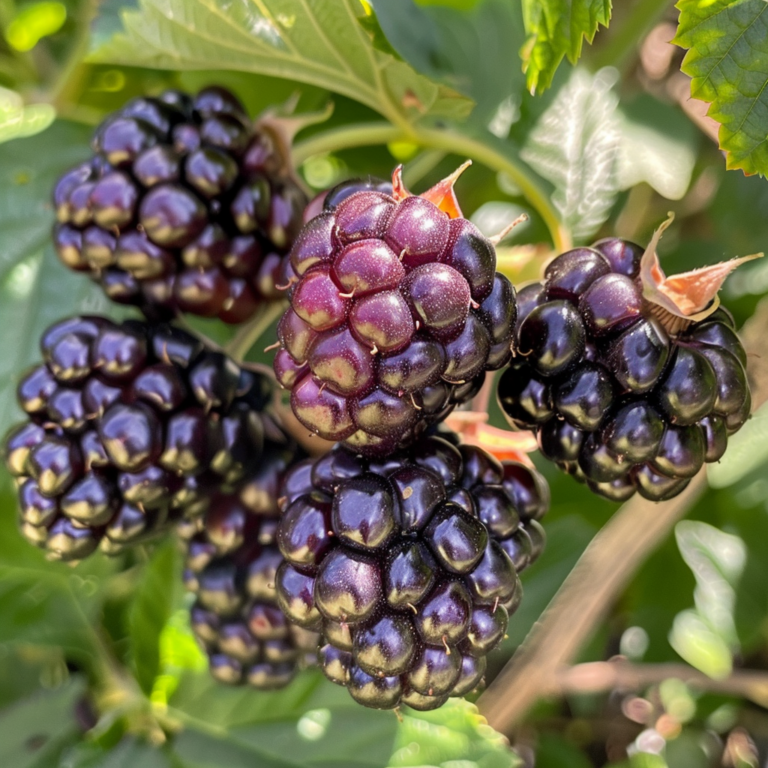Prime Jim Blackberry
Prime Jim Blackberry
Couldn't load pickup availability
| Mature Height | 3-5 ft |
|---|---|
| Mature Width | 3-4 ft |
| Plant Habit | Erect |
| Sunlight | Full |
| Spacing | 3-5 ft |
| Harvest Season | Mid-July to October |
| Growing Zone | 4-8 |
Prime Jim Blackberry is your ticket to enjoying homegrown, sweet, and delicious blackberries with minimal effort. As a primocane fruiting variety, this blackberry delights gardeners with its ability to yield bountiful harvests on the current year's canes, ensuring a continuous supply of fresh berries from summer through fall. With robust growth, these canes are easy to maintain, making Prime Jim Blackberry an excellent choice for both novice and seasoned gardeners alike.
Planting guide
For a successful Prime Jim Blackberry crop, proper planting techniques are essential.
How to plant Prime Jim Blackberry bushes?
Begin by selecting a sunny location that receives at least six to eight hours of direct sunlight daily, ensuring that the soil is slightly acidic to neutral with good drainage. Before planting, work organic matter into the soil to improve its structure and fertility. When ready, dig a hole that’s wide enough to accommodate the root ball comfortably, place the plant, cover it with soil, and water thoroughly.
When to plant Prime Jim Blackberry bushes?
The ideal time to plant Prime Jim Blackberry is in the early spring or late fall when temperatures are moderate. Planting during these times allows the roots to establish before the high stress of summer heat or winter cold. It’s crucial to avoid planting during times of frost or excessive heat to ensure optimal root development.
How far apart should you plant Prime Jim Blackberry bushes?
To support healthy growth and air circulation, Prime Jim Blackberry plants should be spaced about 3 to 5 feet apart. This spacing prevents competition for resources and ensures that each plant receives ample sunlight and airflow. Allowing adequate space also facilitates easy access for maintenance tasks like weeding, pruning, and harvesting.
About
Prime Jim Blackberry grows as a sturdy and bountiful plant with impressive qualities.
How tall does a Prime Jim Blackberry bush grow?
The primocanes of the Prime Jim Blackberry typically grow to a height of 3 to 5 feet. This height allows the plant to support a high yield of berries while staying manageable for garden upkeep. Their compact stature is ideal for small gardens, patios, or any sunny spot you wish to transform into a berry haven.
How long does a Prime Jim Blackberry bush live?
Prime Jim Blackberry plants can thrive and produce fruit for several years with proper care and maintenance. While individual canes die back after fruiting, new canes continuously develop, providing annual harvests. A well-tended patch can remain productive and vigorous for over a decade.
How fast do Prime Jim Blackberry bushes grow?
These blackberries are known for their rapid growth, especially when provided with optimal care and conditions. New canes grow quickly each spring and are ready to produce fruit by mid to late summer of the same year. This fast growth rate ensures a steady supply of fresh blackberries, maximizing enjoyment.
How to care for Prime Jim Blackberry bushes?
Regular care of your Prime Jim Blackberry plants ensures robust growth and a plentiful harvest. Water the plants whenever the top 2 inches of soil is dry to maintain consistent moisture, especially during dry spells. Mulch around the base to keep the roots cool, retain moisture, and prevent weeds from competing for nutrients. Routine monitoring for pests and diseases helps in early identification and management, preserving plant health.
When to prune Prime Jim Blackberry bushes?
Prune Prime Jim Blackberry plants in late winter or early spring before new growth begins. This timing allows you to remove canes that have borne fruit in the previous year, making room for new ones. Pruning at the right time encourages healthy development and optimal fruit production.
How to prune Prime Jim Blackberry bushes?
Start by cutting back any dead or damaged canes to the ground, leaving only healthy new growth. Thin the remaining canes, allowing enough space for good air circulation and sunlight penetration. Tie the remaining canes to a trellis, keeping them spaced and secure to prevent damage and encourage more productive fruiting.
Share

